BREEDING PROGRESS OF NATIONAL SWINE
NUCLEUS HERDS
IN TAIWAN
H. L. CHANG, Z. C. KAO, Y. H. HUANG
and C. TAI
¡¦ Taiwan Livestock Research
Institute, Hsinhua, Tainan,
Taiwan, R.D.C.
¡§Pig Research Institute in Taiwan,
Chunan, Taiwan, R.O.C.
ABSTRACT
Data on 5,325 individually tested
boars and 8,346 group tested gilts in south national nucleus herd (SNNH) between
1983 to 1992 were used to measure annually phenotypic and genetic progress of
average daily gain (ADG) and feed/gain ratio (FE) from 30kg to 110kg for boars
and from 30kg to 90kg for gilts, and backfat thickness (ABF) as well as age at
110kg body weight of boars and at 90kg body weight of gilts. Based on the
phenotypic change of production traits of boars, the superior was ranked in
order of Landrace, Duroc and Yorkshire. When the genetic trend was evaluated,
Duroc boars had more genetic progress on ADG and D110 than the other breeds
did, but the genetic progress on ABF was negative in Duroc boars. Although the
selection index was based on combined performances of ADG, FE and ABF since
1983, three breeds had no genetic improvement on FE annually in boars. Positive
phenotyic improvement was not oberved on ADG of Yorkshire gilts and no genetic
progress on ABF of Duroc gilts either.
A total of 3,799 litters farrowed
by 1191 sots during 1983-1992 in SNNH were analyzed. Numbers of piglets born,
born alive and at 3-week-age per litter in 1992 were: (9.35, 7.98 and 7.71),
(9.87, 8.03 and 7.72) and (9.15, 7.49 and 6.62) for Landrace, Yorkshire and
Duroc breeds, respectively. The corresponding annually phenotypic changes over
the past decade for litter traits were close to zero and it eight be due to
no intention selection for reproductive performances. The North National
Nucleus Herd had better phenotypical progress on litter performance from 1985 to
1990 as compared to that of SNNH.
The elimination of Halothane stress
gene by Halothane test and blood typing was carried out at SNNH starting frow
September of 1990. Currently, the percentage of piglets with Halothane positive
reaction decreased to almost zero in three breeds. In practice, the genetic
marker-assisted selection scheme used at SNNH could provide a breeding model to
private breeding farms.
¡@
I. INTRODUCTION
National Swine Breeding Committee
organized by the Council of Agriculture had set up breeding schemes for two
national nucleus herds located at northern Chunan (NNNH) and southern
Hsinhua(SNNH). The aims of national nucleus herds are to select superior
purebred pigs, mainly Landrace, Yorkshire and Duroc breeds, to take performance
test and to propagate and extend stocks all over the nation. Three major
purposes are as follows:
1. To breed stocks with better
adapting to the climate of Taiwan; and to have hogs with more lean meat and
higher feed efficiency by meeting the requirement of consumers and producers;
2. To demonstrate the enterprising
management system. to general hog farmers; and
3. To promote governmental stocks
supplying system in order to help those small scale farmers at the designated
hog raising region to produce 3-way cross hogs. Therefore, the difference of
breeding level between small farms and enterprised companies can be balanced
out. (Chyr 1987).
The management systems and breeding
schemes carried out in two national nucleaus herds are more or less in similar
way. Litters were born in individual farrowing crates. At weaning (around 32-38
days of age), piglets were brought to a post-weaning building where they were
housed in pens of around 8-10 animals. The creep diet was provided ad libitum to
piglets from 14 days of age. At 12-week-age, pigs with at least 25 Kg of body
weight and 12 apparently functional nipples, adequate leg strength, and a
satisfactory body development were chosen for performance test based on two
males and two to four females per litter.
Boars were tested for production
performance in individual pens from 30 Kg to 110 Kg of body weight and gilts
were tested in group from 30 Kg to 90 Kg of body weight. All pigs were fed at
libitum during test period. The backfat thickness was probed at the end of
testing in both sexes. Average daily gain (ADG) and feed/gain ratio (FE)
from 30 Kg to 110 Kg of body weight in boars, backfat thickness (ABF) and age
to 110 Kg and 90 Kg for boars and gilts were combined onto the selection
index at herdmate comparison test. The selection indexes used before July of
1991 for gilts and boars were as follows:
¡@
¡V For gilts
I = 100 + 180 (ADG -ADG) ¡V 50 (ABF
¡V ABF)
¡V For boars,
I = 100 + 60 (ADG ¡V ADG) ¡V 40 (FE ¡V
FE) ¡V 45 (ABF ¡V ABF)
whereas, after July of 1991, the
index for Landrace and Yorkshire boars was reset to
I = 100 + 130 (ADO ¡V ADG) ¡V 40 (FE
¡V FE) ¡V 40 (ABF ¡V ABF)
The top 2% and 25% of performance
tested boars and gilts, respectively, with satisfactory leg strength were then
selected as potential breeding stocks. In order to speed up the breeding
progress, the top 5% boars from Central Test Station yearly could be introduced
into nucleus herds.
II. THE IMPROVEMENT OF PRODUCTION
TRAITS
A total of 2,140 Landrace, 1,424
Yorkshire and 1,761 Duroc boars tested at individual pen; and 4,321 Landrace,
1,893 Yorkshire and 2,132 Duroc gilts tested at group basis from south National
Nucleus Herd (SNNH) during the period of 1983 to 1992 were analyzed to
predicted annual phenotypic and genetic improvement of production traits:
average daily gain (ADG, from 30kg to 110kg for boars and from 30kg to 90kg for
gilts), backfat thickness (ABF, adjusted at 110kg for boars and at 90kg for
gilts), feed/gain ratio (FE) for boars and age at 110kg (9110) for boars as
well as age at 90kg (D90) for gilts. The evoluation of number of boars and
gilts tested are represented on Fig. 1 and 6. Landrace breed is used as dam
line in 3-way cross hog production system, so the averages of number of pigs
tested yearly in both sexes were larger than the other two breeds which were
almost even in numbers of tested pigs.
Multivariate mixed linear models
techniques (Henderson,1984) were used for analysis. Restricted maximum
likelihood (REML) via the EM algorithm (Dempster et al., 1977) was used for
estimating the necessary variances and covariances for additive genetic effects
and residuals. Best linear unbiased prediction of genetic values and best linear
unbiased estimates of marginal means by year of birth were obtained solving
mixed-linear equations, conditionally on the REML estimates of variances and
covariances. The statistical model entertained for ADG, FE, D110 and D90 had
taken into account not only fixed effects of year of birth, of testing season,
of parity and of litter size which pig was born with body weights at test
starting and finished as covariates, but also random effects of animal and
residuals. The model employed for ABF included all effects as above excluding
the body weight at test starting.
The variations of the main
productive performances in tested boars and gilts by year of birth from 1983 to
1992 are shown in Fig. 2¡V5 and Fig. 7¡V9, respectively. The main results
indicated that the selection criteria used was most beneficial to Landrace
breed in both sexes for traits considered. Also, the production performances
of Yorkshire breed were superior to those of Duroc breed in boars. However,
it was not the case in gilts as shown in Fig. 7 ¡V 9.
¡@
The predicted annual phenotypic
change of tested boars and gilts from 1983 to 1992 are listed in tables 1 and
2, respectively.. Over the last ten years, the means of phenotypic yearly
improvement on ADG, ABF and D110 in Landrace, Yorkshire and Duroc boars annually
were (15.79gm, -0.29mm and -1.96day), (-1.81gm, -0.10mm and 0.52day) ard
(2.94gm, -0.15mm and %.37day), respectively. Comparisons on phenotypic
changes of production traits in boars indicated that Landrace, Duroc and
Yorkshire performed as they were. However, Duroc boars had more genetic
progress on ADG and D110 than the other breeds did. However, the genetic
progress on ABF in Duroc boars was negative. There was no phenotypic or
genetic progress on FE of boars. When daily gain of gilts was considered, the
positive genetic progress was found in all three breeds. Although similar
results was shown in predicted annual phenotypic progress in backfat thickness
adjusted at 90Kg weight, the yearly genetic improvement was not different from
zero in all breeds considered.
The breeding scheme based on
selection index described above at SNNH was practised in NNNH. The results are
listed in tables 3 and 4 for boars and gilts, respectively. There were 3,771
boars and 8,020 gilts tested at NNNH during 1986-1991 and during 1985-1990,
respectively. Landrace boars had more phenotypical progresses on ADG and FE
which were consistent with those found at SNNH. The similar trend was also
observed in gilts at NNNH although it was not the case in gilts at SNNH.
III. THE
ELIMINATION OF SENSITIVITY TO HALOTHANE GENE IN SNNH
Quality control of pork in Taiwan
is important to swine industry. The physics and chemistry of hog caress
postmortem can be affected by an autosomal locus (Hal) with two alleles N and
n. Pigs with genotypes NN and Nn are not sensitive to Halothane test (Hal-)
and are non-susceptible to malignant hyperthermia (MH) under various stress
conditions, while pigs with genotype nn are sensitive to halothane (Hal+) and
are susceptible to NH. Despite the halothane gene¡¦s favorable effect on lean
content, the Hal-n allele results in a net loss in pig production as the
Hal+(nn) pigs suffer more death losses during the fattening period or
transportation, and have lower litter size as well as are highly liable to
develop PSE or DFD meat postmortem.
In order to reduce the proportion
of halothane sensitive pigs, the SNNH had a two-year screen project for
Halothane gene starting from September of 1990. After two years with Halothane
screen test, the percentages of piglets with Hal+(nn) are close to zeros in
all breeds. The variation of frequencies for halothane positive piglets by the
month of test within breed is presented on Fig. 10A. However, the halothane
test has difficulty to identify genotype NN and Nn pigs. Phosphohexose
Isomerase (PHI) and 6-Phosphogluconate dehydrogenase (PGD) of blood
markers have been used to help identify the genotypes after October of 1991.
The frequencies of blood type (AA, hB and BB) for PHI and PGD within breed
are shown in Fig. 108. The results indicated that PHI-A allele was linked to
PGD-B allele tightly in Landrace breed and PHI-A allele is linked to PGD-A
allele in both Yorkshire and Duroc breeds.
IV. THE
IMPROVEMENT OF .l.lTTER TRAITS
Sow reproduction is an
economically important aspect of pig production and improving sow productivity
is a mjor way to increase the efficiency in pig production system (Tess et al.,
1983; Legault, 1985; 1989). Litter size is recognized as a major factor
affecting the saws¡¦ productivity in terms of number of piglets weaned per sow
per year. However, increasing litter size by genetic or environmental means has
been difficult at best (Cunningham et al., 1979; Ollivier, 1982) due to its low
heritability and repeatbility. Under the concept of above, the traits of
interest and of analyzed were: number of piglets born (LSO), number of
piglets born alive (LSA) and number of piglets at 3-week-age (LS3).
Data of 3,799 litters of Landrace,
Yorkshire and Duroc breeds produced by 1,191 sots during 1983-1992 at SNNH
were analyzed. Three litter traits (LSO, LSA and LS3) were described by mixed
linear models and analyzed using the methods described in the analysis of
production traits. The model employed first included year of farrowing, season
of farrowing and littermate size effect when the sow was born, as fixed
effects, and additive genetic effects as random variable. Because none of the
ratio of additive genetic variance to corresponding residual variance in traits
considered was larger than 10-8 when evaluated at the REML estimates
of the components of variance, the additive genetic effects was eliminated.
Therefore, the model used for analysis of litter traits became fixed.
The summary variation of litter
performances are represented in Fig. 11 for LSO, LSA and LS3, and the
variations of litter traits within breeds are shown in Fig. 12¡V14. In summary,
Duroc breed had one piglet less at 3-week-age as compared to that of Landrace
or Yorkshire breed over the last decade. The estimated annual phenotypic
change of litter performance at SNNH is listed in table 5. During last ten
years, the annually phenotypic changes for litter size at 3-week-age were
positive with the exception of Landrace breed. However, none of yearly
changes in litter traits considered was significantly different from zero in
each breed at SNNH. The similar result was also found in overall evaluation for
traits considered in the same herd.
More than 2,500 litters produced by
NNNH were used to evaluate litter performance and corresponding phenotypic
improvement. The statistical model employed was fixed effect model which
included year of farrowing, season of mating, parity and interaction between
season of mating and parity. The variation of litter traits as mentioned
above from 198l to 1992 are shown in Fig. 15. The results indicated that
survival rate at 3-week-age was about 82% to 85% with the exception of 1987.
The estimates of phenotypic improvement yearly for litter traits are listed in
Table 6. Landrace breed had more phenotypical progress on litter size and litter
weight.
V. IMPLIGATION
National Swine Nucleus Herd at
North and at South in Taiwan have presented an example of breeding scheme for
genetic improvement of production and reproduction traits in Landrace, Yorkshire
and Duroc breeds for the last decade by using a combined index of ADG, FE and
ABF. Although the genetic improvement for each trait among breeds was
inconsistent with few exception, the reproduction performance of sows showed no
significant decreases in litter size and weight. In conclusion, National
Nucleus Herds have demonstrated a selection scheme with emphasis on growth
performance test for private breeding farms and will recommend the necessary of
setting up a national program on genetic marker-assisted selection for
elimination of halothane stress gene.
¡@
ACKNOWLEDGEMENTS
We are grateful to Dr. M. C. Wu
for his kind assistance and contribution of halothane test data. Ifr.
D. Y. Lin and Mrs. H. R. Tsai are thanked for their skillful help in
preparing the manuscript.
REFERENCES BlBLIOGRAPHIQUES
Bidanel, 3. P., J. C. Caritez
and C. Legault. 1989. Estimation of crossbreeding parameters between Large
White and Eeishan porcine breeds. I. Reproductive performance. Genet. Sel.
Evol. 21:507%26.
Chyr, Shuang - Ching. 1987. Pig
breeding and development in Taiwan. The Proceedings of Pig Breeding and
Development in Asia. April 26 ¡V May 3, 1987, ASPAC FFTC, pp.C1-45.
Cunningham, P. J.,M. E.
England, L. D. Young and D. R. Zimmerman. 1979. Selection for ovulation
rate in swine: correlated response in litter size and weight. J. Anim. Sci.
48: 509-516.
Dempster, A. P., N. M. Laird
and D. B. Rubin. 1977. Maximum likelihood from incomplete data via the
EM algorithm. 3. R. Stat. Soc.(B) 39:1-38.
Henderson, C. R. 1984.
Application of linear models in animal breeding. University of Guelph, Ontario,
462pp.
Legault, C. 1985. Selection of
breeds, strains and individual pigs for prolificacy. J. Reprod. Fert. Suppl.
33:1S1-166.
Ollivier, L. 1982. Selection for
prolificacy in the pig. Pig News and Information, 3:383-388.
Tess,
M. W., G. L. Bennett and G. E. Dickerson. 1983. Simulation of genetic
changes in life cycle efficiency of pork production. II. Effects
components on efficiency. J. Anim. Sci. 56:354-368.
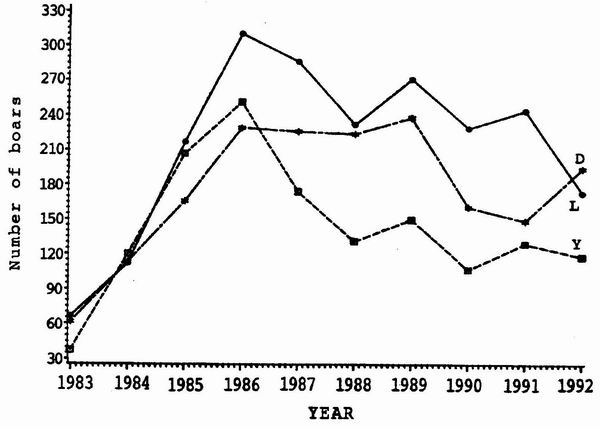
Fig.1 The evolution of numbes of boars tested for Landrace,
Yorkshire, Duroc breeds in SNNH
¡@ |
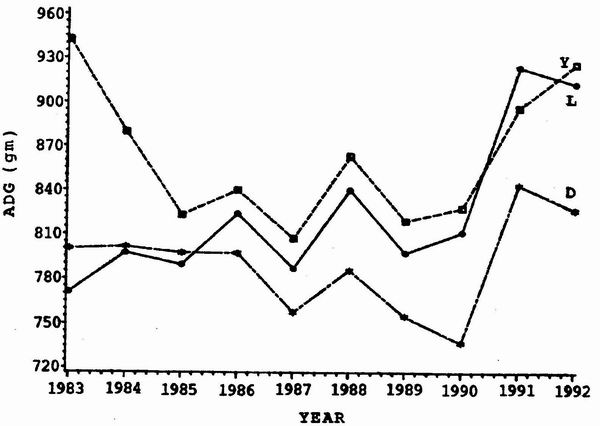
Fig. 2 Average daily gain (ADG)by year of birth for boars tested in
SNNH
¡@ |
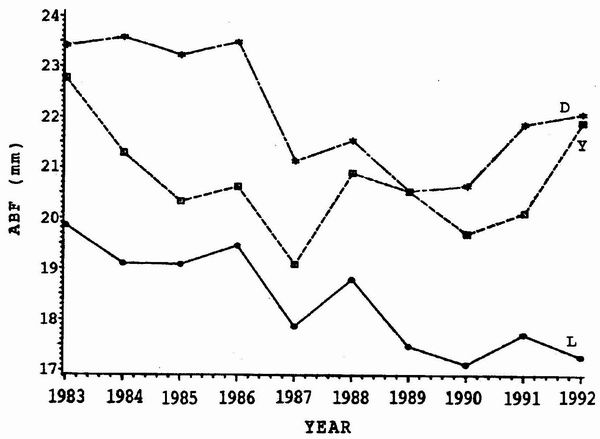
Fig.3 Average backfat thickness at 110kg (ABF) by year of birth for
boars tested in SNNH
¡@ |
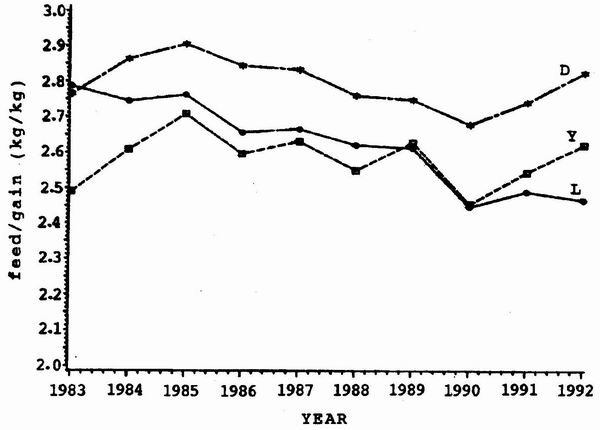
Fig.4 Average feed/gain ratio by year of birth for boars tested in
SNNH
¡@ |
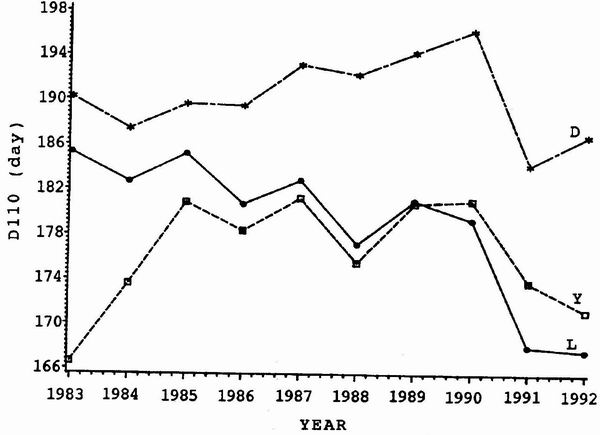
Fig.5 Average age a 110kg (D110) by year of birth for boars tested
in SNNH
¡@ |
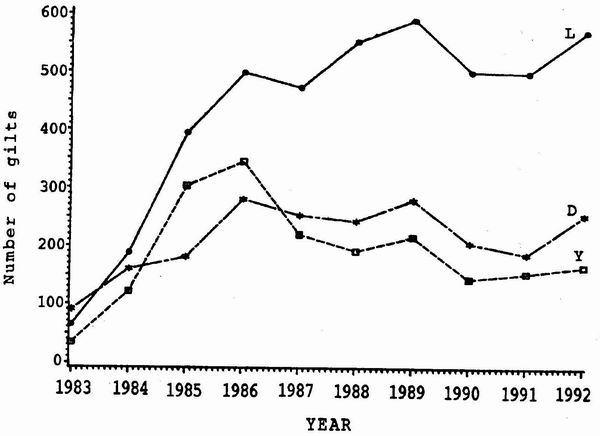
Fig. 6 The evolution of numbers of gilts tested for Landrace,
Yorkshire, Duroc breeds in SNNH
¡@ |
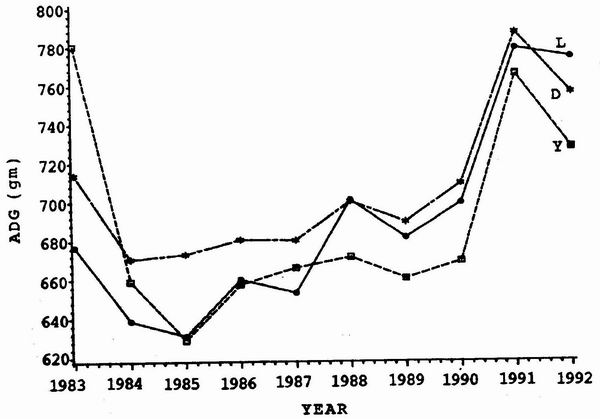
Fig.7 Average daily gain (ADG) by year of birth for gilts tested in
SNNH
¡@ |
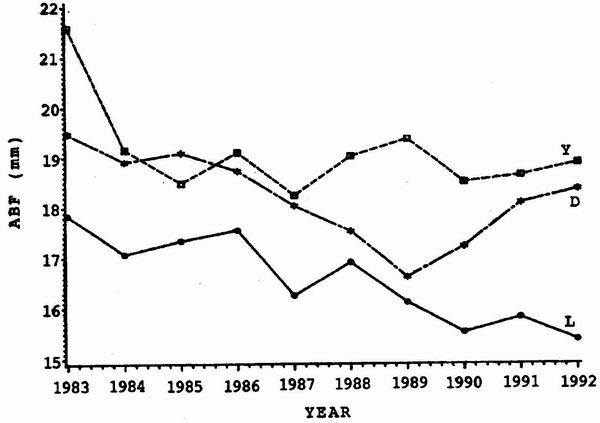
Fig. 8 Average backfat thickness at 90kg (ABF) by year of birth for
gilts tested in SNNH
¡@ |
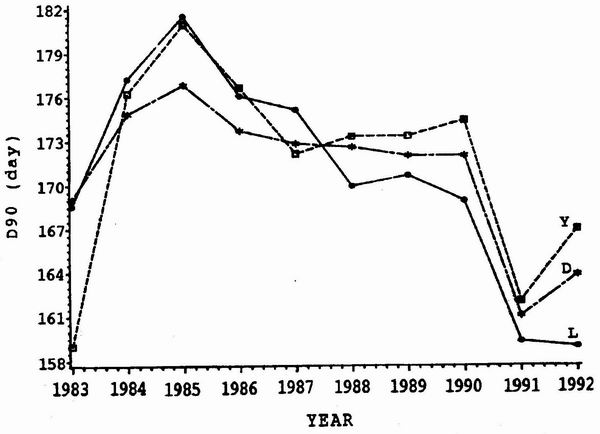
Fig.9 Average age at 90kg (D90) by year of birth for gilts tested in
SNNH
¡@ |
|
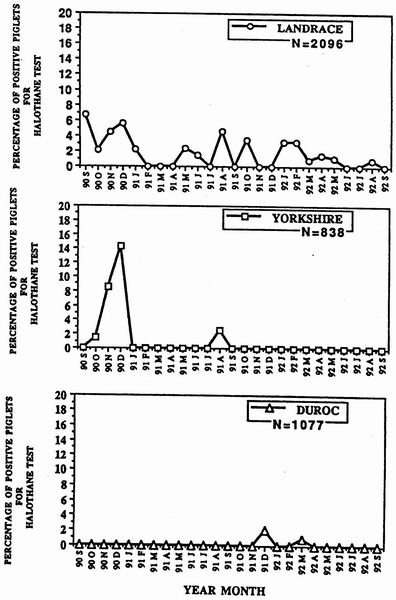
Fig. 10A Frequencies of halothane positive piglets In Landrace,
Yorkshire and
Duroc breeds during September 1990 to September 1992 in SNNH
¡@ |
|
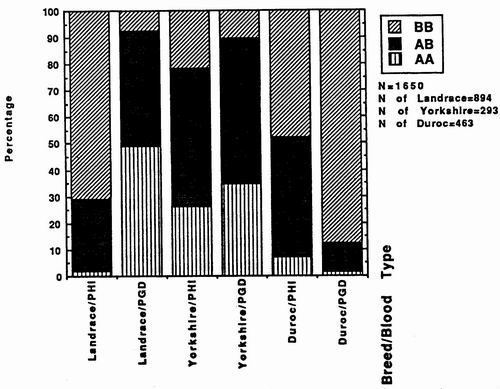
Fig 10B. Frequencies of blood type (AA, AB, BB) of PHI and PGD in
Landrace, Yorkshire and
Duroc pigs finishing performance test during October 1991- September
1992 in SNNH
¡@ |
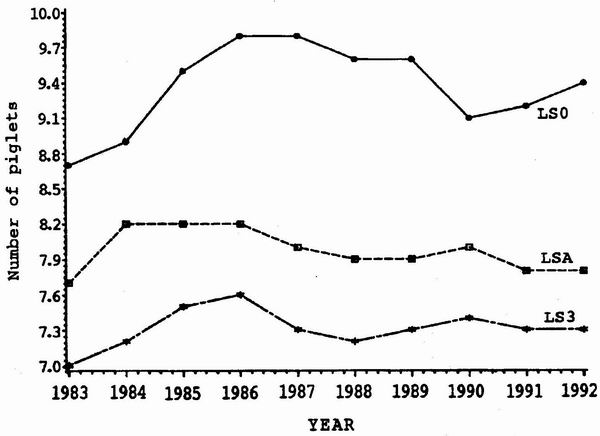
Fig. 11 Variation of number of piglets born (LS0), born alive (LSA)
and
at 3-week-age (LS3) per litter in SNNH
¡@ |
|
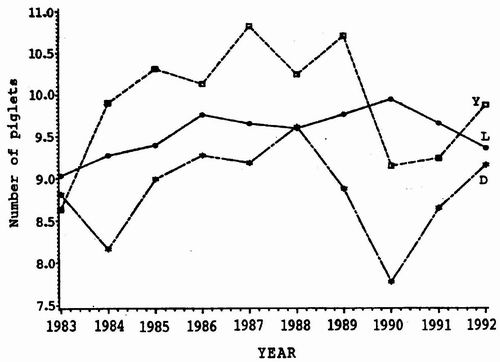
Fig. 12 Number of piglets born per litter for Landrace(L),
Yorkshire(Y) and Duroc(D) in SNNH
¡@ |
|
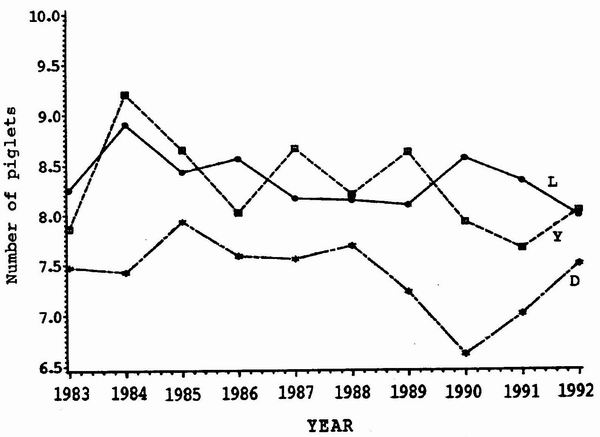
Fig.13 Number of piglets born alive per litter in SNNH
¡@ |
|
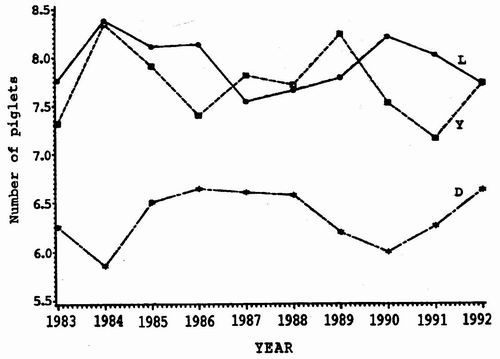
Fig. 14 Number of piglets at 3-week-age per litter in SNNH
¡@ |
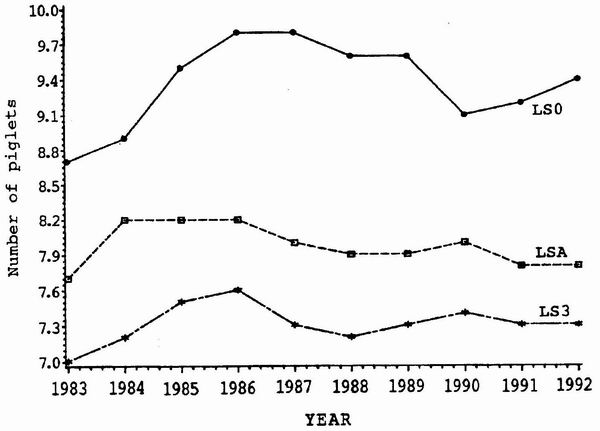
Fig. 15 Variation of number of piglets born (LS0), born alive (LSA)
and
3-week-age (LS3) per litter during 1983-1992 in SNNH |
¡@
Table 1. Predicted annual phenotypic
and genetic change of growth performance for tested boars born in SNNH during
1983-1992
|
Character |
Breed |
|
Landrace |
Yorkshire |
Duroc |
|
Number
of Boars |
2,140 |
1,424 |
1,761 |
|
Phenotypic Change |
|
|
|
|
ADG
(gm) |
15.79 |
¡V 1.81 |
2.94 |
|
ABF
(mm) |
¡V 0.29 |
¡V0.10 |
¡V 0.15 |
|
Feed/Gain (Kg/Kg) |
¡V 0.04 |
0.01 |
0.01 |
|
D110
(Day) |
¡V 1.96 |
0.52 |
¡V 0.37 |
|
|
|
|
|
|
Genetic
Change |
|
|
|
|
ADG
(gm) |
0.15 |
0.09 |
4.46 |
|
ABF
(mm) |
¡V 0.05 |
¡V 0.31 |
0.07 |
|
Feed/Gain (Kg/Kg) |
0.00 |
0.00 |
0.00 |
|
D110
(Day) |
¡V 0.12 |
¡V 0.12 |
-0.55 |
Table 2. Predicted annual phenotypic
and genetic change of growth performance for tested gilts born in SNNH during
1983-1992
|
Character |
Breed |
|
Landrace |
Yorkshire |
Duroc |
|
Number
of Gilts |
4,321 |
1,893 |
2,132 |
|
Phenotypic Change |
|
|
|
|
ADG
(gm) |
10.81 |
-5.89 |
4.65 |
|
ABF
(mm) |
-0.28 |
-0.30 |
-0.13 |
|
D90
(Day) |
-1.07 |
0.88 |
-0.58 |
|
|
|
|
|
|
Genetic
Change |
|
|
|
|
ADG
(gm) |
1.62 |
1.93 |
4.56 |
|
ABF
(mm) |
-0.02 |
0.00 |
0.06 |
|
D90
(Day) |
-0.26 |
-0.23 |
-0.59 |
¡@
Table 3. Predicted annual phenotypic
change of growth performance for tested boars born in NNNH during 1986-1991
|
Character |
Breed |
|
Landrace |
Yorkshire |
Duroc |
|
Number
of Boars |
846 |
854 |
2,071 |
|
ADG
(gm) |
10.00 |
2.00 |
2.00 |
|
ABF
(mm) |
0.01 |
-0.01 |
-0.01 |
|
Feed/Gain (Kg/Kg) |
-1.22 |
-0.78 |
-1.06 |
|
D110
(Day) |
1.60 |
1.40 |
0.40 |
Table 4. Estimated annual phenotypic
change of growth performance for tested gilts born in NNNH during 1985-1990
|
Character |
Breed |
|
Landrace |
Yorkshire |
Duroc |
|
Number
of Gilts |
3,222 |
2,361 |
2,437 |
|
ADG
(gm) |
14.50 |
5.47 |
1.69 |
|
ABF
(mm) |
-1.36 |
-0.44 |
0.45 |
|
D90
(Day) |
-0.69 |
-0.35 |
-0.58 |
Table 5. Estimated annual phenotypic
change of litter performance for sows in SNNH during 1983-1992
|
Character |
Breed |
Overall |
|
Landrace |
Yorkshire |
Duroc |
|
Number
of litters |
1,832 |
905 |
1,062 |
3,799 |
|
Number
of piglets |
|
|
|
|
|
Born |
0.05 |
0.14 |
0.04 |
0.08 |
|
Born
alive |
-0.03 |
0.02 |
-0.00 |
-0.04 |
|
At
3-week-age |
-0.04 |
0.04 |
0.04 |
0.03 |
Table 6.
Estimated annual phenotypic change of litter performance for sows in NNNH during
1985-1990
|
Character |
Breed |
|
Landrace |
Yorkshire |
Duroc |
|
Number
of piglets |
|
|
|
|
Born |
0.30(1,054) |
0.03(700) |
0.24(1,146) |
|
Born
alive |
0.27(1,045) |
0.08(689) |
0.20(1,124) |
|
At
3-week-age |
0.23(984) |
0.17(642) |
0.15(1,037) |
|
Litter
weight(Kg) |
|
|
|
|
At
birth |
0.53(1,037) |
0.30(682) |
0.49(1,110) |
|
At
3-week-age |
2.01(984) |
1.20(642) |
1.01(1,037) |
Value
in parentheses is number of litters evaluated.














